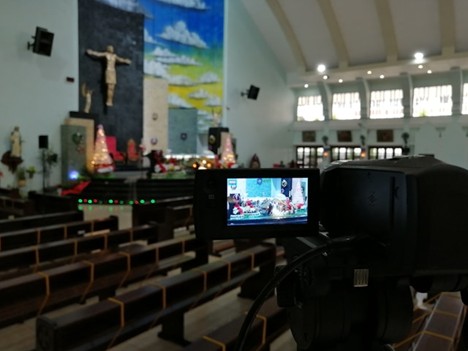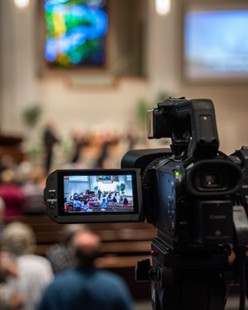
Live streaming has become an essential part of modern worship. Whether due to illness, travel, or living at a distance, many congregants aren’t able to attend in person every week. Live streaming bridges that gap, allowing individuals to remain spiritually engaged no matter where they are. However, delivering a meaningful virtual experience requires more than just pointing a camera and hitting “go.” At the core of any impactful stream is clear, high-quality audio.
Successfully integrating your sanctuary’s sound system with a live streaming platform involves more than basic hookups - it requires careful attention to signal routing, synchronization, and audio mixing tailored for remote listeners. From managing latency to choosing the right tools for clean vocal capture - such as a lavalier microphone for hands-free speaking - technical decisions make a major difference in the online worship experience.
This article dives into the process of integrating audio systems for seamless live streaming in worship spaces, helping ensure that your virtual congregation can clearly hear every message, song, and sacred moment.
When people think about live streaming, they often focus on visual components - camera angles, lighting, video resolution. But seasoned streamers know that audio is what makes or breaks a remote worship experience. Poor sound quality leads to frustration and distraction, causing viewers to disengage. In contrast, clear and well-balanced audio fosters immersion and spiritual connection, even through a screen. In fact, 78% of churches in the U.S. offered online streaming services in 2023.
For this reason, integrating your sanctuary’s voice and instrument amplification system with your streaming setup is crucial. Simply pointing a camera at the pulpit and hoping for the best isn't enough. You need to feed a clean, balanced audio signal into your stream, optimized specifically for remote listening.
In-person listeners hear audio through a combination of loudspeakers and room acoustics. Online listeners, however, are hearing a compressed version through earbuds, mobile phones, or home speakers. What sounds good in the sanctuary may sound muddy or unbalanced online unless mixed appropriately.
Some churches try to use the same mix from the sanctuary soundboard for streaming. However, that mix is tailored for in-room dynamics and doesn't always translate well to the stream. Online worshippers may struggle to hear spoken word, vocals, or acoustic instruments if the levels aren’t adjusted for a digital audience.
Audio that lags behind video, or vice versa, can distract viewers. Syncing sound and video streams in real time requires attention to latency, buffering, and equipment compatibility.
Too often, churches either over-engineer their systems with unnecessary gear or rely on improvised, inconsistent setups. A successful integration strikes a balance: investing in the right tools and using them effectively without overcomplicating operations.
To integrate sound seamlessly into your live streaming workflow, you need several core components working together in harmony:
This is the primary control point for your in-room audio. It routes vocals, instruments, spoken word, and other sound sources to the sanctuary speakers. Many churches use digital mixers that can be expanded or networked with additional components.
Instead of sending the same mix to your stream and your sanctuary, it’s best to create a dedicated mix for the live stream. This can be done through:
This dedicated mix allows for adjusting levels specifically for online clarity, for instance, boosting the sermon mic while reducing ambient crowd sounds.

To get the signal from your mixer into your streaming software, you’ll need an audio interface. This device converts analog or digital audio signals into a format your computer or encoder can use. Some modern mixers include built-in USB or Dante outputs that eliminate the need for an external interface.
Your computer runs the streaming software (like OBS, Wirecast, or vMix), or you might use a dedicated hardware encoder. The sound input from your mixer must be properly recognized and configured in your software. This is where synchronization with video also takes place.
Don’t rely solely on what you hear in the sanctuary. Designate a streaming operator to monitor the live feed through headphones or speakers similar to what viewers will use. This ensures the mix sounds great for your online audience, not just in-house.
Here are several strategies for crafting a mix that resonates with your remote viewers:
Ensure that voice pickup from speakers, preachers, and scripture readers is clear and intelligible. This usually means EQ adjustments to reduce muddiness, applying compression to even out dynamics, and raising volume levels slightly in the streaming mix.
In-room music benefits from natural acoustics and speaker placement. Online listeners don’t have that. You may need to increase vocal leads, reduce drum levels, or add reverb and EQ enhancements specifically for the stream. Use multitrack recording to analyze what your stream sounds like and adjust accordingly.
A purely direct-feed mix may sound sterile online. Adding ambient microphones placed in the sanctuary can capture audience response, room warmth, and natural reverb. Blend these subtly into your stream mix for a more lifelike audio experience.
At Grace Renewal Church, a 300-seat sanctuary began streaming services during the pandemic. Initially, the team used a smartphone and a plug-in mic. However, the sound lacked quality and consistency. They upgraded to a digital mixer with a dedicated streaming bus, routed through an audio interface into OBS Studio.
They also assigned a volunteer to monitor the stream weekly. This person could adjust vocal balance on the fly and flag sync issues. Today, Grace Renewal’s stream reaches over 1,200 weekly viewers, many of whom report feeling deeply connected—largely due to the upgraded audio experience.
Technical setups are only as good as the people running them. Once your system is in place:
A sustainable system doesn’t require expert engineers—it just needs clarity, consistency, and a commitment to excellence.
Technology evolves, and so will your needs. Here’s how to future-proof your investment:
Choose scalable gear: Digital mixers with networked outputs can expand as your team or tech demands grow.
Use open-source or popular software: Tools like OBS and vMix are updated frequently and have strong support communities.
Invest in training: As you upgrade, continue educating your team. The more they understand the system, the more seamless the experience becomes for your online worshippers.
At its core, integrating audio systems for live streaming is about more than equipment—it’s about ministry. You're not just pushing signals to the internet; you're transmitting moments of praise, healing, teaching, and inspiration.
By designing an audio setup that prioritizes clarity, flexibility, and sustainability, your church can reach hearts beyond its walls - bringing the sanctuary to wherever the congregation may be.
Whether you're just getting started or looking to refine your current setup, remember: the most powerful stream isn’t just seen - it’s heard, deeply and clearly.